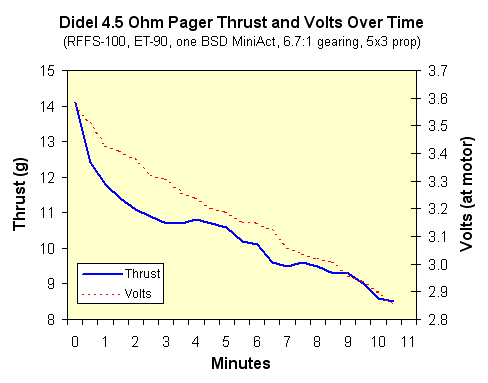How to use Table 2
Here's how to use Table 2. Spec out your plane to figure out the maximum size prop you are willing to have on it. If you don't care about taking off from the ground you may be willing to accept a prop that is longer than the landing gear. Once you have your prop size, find something close in the table that has a motor RPM close to the max power RPM and has a good thrust compared to other similar sized props. I've highlighted one prop in each gearing category that is a good choice, although others may be acceptable too. Next compare the static thrust with some of the rules of thumb about how much thrust to weight you need and compare this to your estimated plane weight. A good one for indoor models is that if your static thrust is at least equal to 1/4 your model weight it will be able to fly, and equal to 1 your model weight it will fly well, and equal to 3 it will be aerobatic. So, if you have a plane that is not excessively draggy, like a biplane, and it weighs 15g and you choose a prop and gear combination that yields 10g static thrust you will have a great performing plane. Alternately some people prefer a watts/ounce rule that at 1.5 watts/ounce the model will have average performance, 2.0 is about right for a typical sports model, and 2.5 will give aerobatic performance. In this case a 3.5x2.7 prop geared 4:1 would be a good choice. These rules of thumb are thanks to John Worth, Bob Aberle, and Don Srull.

Thrust Over Time
I can almost hear someone reading this thinking “I wonder if I can make a pager plane with this motor that will hover?” The graph below shows the results from a test designed to simulate full throttle over time. All the previous tests were powered by a laboratory power supply straight to the motor, with volts measured at the motor terminals. This test powered the motor via an RFFS-100 receiver, with a single BSD MiniAct hooked up, and powered by a freshly charged ET-90 cell. During the test I operated the actuator back and forth to put an additional load on the cell due to actuator use. I measured volts under load at the battery and also at the motor terminals. Volts at the motor terminals were about 0.15 volts lower than at the battery throughout the test. The test was terminated when volts at the battery dropped below 3.0 volts.
This test represents an extreme test of the propulsion system and the ET-90 cell. Thrust drops steadily during the test from about 14g to 8.5g. Volts under load at the motor also drops steadily from 3.6 to 2.9 volts. During the first three minutes of discharge the average thrust is 11.8g and the average volts is 3.4. Over the remaining 7.5 minutes of discharge the average thrust is 9.8g and average volts is 3.1. These are very encouraging results. Since most of us don't fly our micro planes at full throttle for the entire flight we will have power for the occasional loop if the plane is relatively light. If we choose to cruise around at partial throttle the flight time will be considerably longer than 10 minutes. Now about that hovering. If someone builds a plane light enough to hover, these results show that the hovering will have to be done in the first couple of minutes of the discharge.
